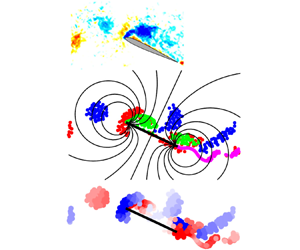Published online by Cambridge University Press: 01 July 2021

While studies on unsteady airfoils in a uniform free stream are abundant, the quest for efficient man-made propulsion and energy harvesting calls for an improved understanding and predictive capability of unsteady airfoils encountering external flow disturbances. In this paper, we conduct experimental and theoretical investigations of the interactions between an airfoil engaged in unsteady motion and external flow disturbances generated by an upstream source. The flow field interactions are experimentally studied using particle-image velocimetry and finite-time Lyapunov exponent techniques. An interesting outcome of the interactions is an interruption of leading-edge vortex (LEV) shedding from the airfoil and a consequent modulation of the lift history, which are dependent on the phase of the disturbances relative to the airfoil kinematics. A low-order model for an unsteady airfoil encountering the disturbances is built upon the leading-edge suction parameter (LESP)-modulated discrete-vortex method (LDVM) developed by Ramesh et al. (J. Fluid Mech., vol. 751, 2014, pp. 500–538). The LDVM distils the determination of the LEV shedding characteristics of unsteady airfoils to a single parameter, the LESP. We show that the LDVM, modified for the current work, is able to predict the effect of the disturbances on the LEV shedding characteristics of the airfoil and the associated lift history in good agreement with experimental observations. In addition to being a predictive tool, the LDVM also augments the experimental study by providing a theoretical framework and various graphical approaches to analyse the flow phenomena from a fundamental perspective and elucidate the role of different factors governing the flow field evolution.